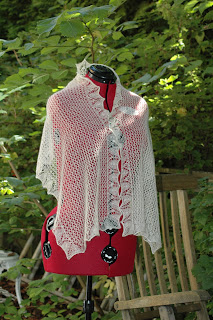One of the most beloved patterns in the Estonian tradition of lace knitting is the 'Lillies of the Vally' pattern. There are numerous variations on this pattern, all with nobs on a bent stalk. I just had to make a shawl with a Lilies of the Vally pattern for my book project. I chose my absolute favourite among these patterns, and made this shawl.

It has a very simple and traditional design, with a centre with the Lilies of the Vally patter and a rounded outer border. I found both patterns in Nancy Bush's book "Knitted Laces of Estonia", but you may find this Lilies of the Vally pattern i many other books as well, e.g. in Siiri Reimanns book "The Haapsalu Shawl".
When you learn to knit the nobs, this is not a terribly difficult shawl to knit. However, there are some special stitches that needs to be mastered first. The pattern is also relatively complex, so it takes some time to remember it all. But the end results is always very pretty, and the pattern becomes very beautiful after blocking.
The pattern is also relatively complex, so it takes some time to remember it all. But the end results is always very pretty, and the pattern becomes very beautiful after blocking.
 The pattern is also relatively complex, so it takes some time to remember it all. But the end results is always very pretty, and the pattern becomes very beautiful after blocking.
The pattern is also relatively complex, so it takes some time to remember it all. But the end results is always very pretty, and the pattern becomes very beautiful after blocking.

















